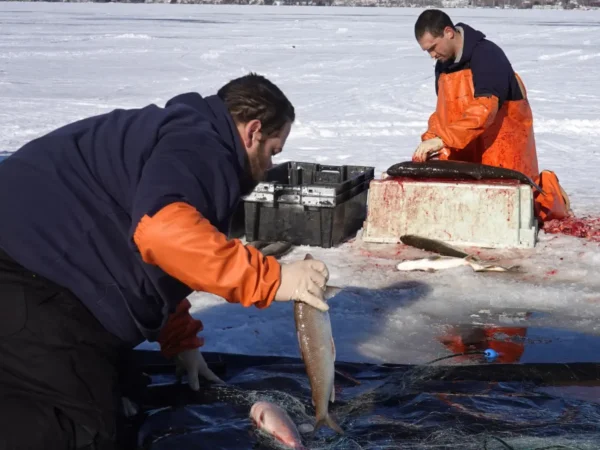
Salt-speckled sidewalks, driveways and highways are synonymous with winter in the Great Lakes region. But while road salt is highly effective at de-icing surfaces, the safety that salt provides for humans places a heavy burden on freshwater ecosystems.
“We have an unhealthy addiction to road salt,” said Claire Oswald, a hydrologist and associate professor at Ryerson University in Toronto, Ontario. Multiple studies dating back to the 1970s have shown that road de-icing salt has a negative impact on soil, vegetation, wildlife, surface water, groundwater and human health. A 1984 study conducted by the Michigan Legislative Science Office states road de-icing salts, “are contributing to major changes in the Great Lakes ecosystem,” particularly on sensitive environments like wetlands, ponds and streams. Additionally, the legislative study found road salts are contributing to a general degradation of groundwater quality for all users in the Great Lakes region.
In the late 1990s, Oswald said the Canadian government started to take a hard look at road salt usage and best management plans. The Canadian Water Quality Guidelines include the maximum thresholds for when chloride becomes harmful to amphibians, algae, aquatic plants, aquatic insects, fish and invertebrates like mussels, she said.
While maintaining safe roadways, parking lots and sidewalks is necessary, Oswald believes most people are not aware of the full environmental costs to freshwater systems from road salts.
Danelle Haake, stream ecologist and director of Illinois RiverWatch, agrees.
“If you ask someone in the grocery store about road salt, they probably have no idea of the negative environmental consequences,” Haake said.
Haake said there is currently no way to stop the sodium chloride from entering storm drains and eventually the groundwater. She said some of the sodium stays in the ground, but for the most part the chloride flushes through soil until it reaches water. This makes bioremediation options like rain gardens and bioswales ineffective.

Salt on stairs (Photo Credit: Kathy Johnson)
“Plants don’t produce salt. And they don’t absorb it. And they don’t hold it,” Haake said.
Haake said road salt hazards are not limited to freshwater ecosystems. She said sodium chloride has been found to degrade roadways and bridges, cause damage to cars and trucks, and even affect human health.
A high-salt diet contributes to high blood pressure, heart disease and strokes, according to the CDC. Residences and businesses located near roadways and using well-water in areas with high snowfall where road salt is used are at risk of having high chloride levels in their tap water, Haake said.
“If you’re drinking tap water with a lot of salt, it’s like eating salty fries all day long,” Haake said.
API key not valid. Please pass a valid API key.Seeking Safe Alternatives
Synthetic de-icers are typically expensive which has limited their widespread use. Researchers also caution against trading salt for an artificial product.
“The last thing we want is some new plastic-based material that doesn’t break down,” Haake said.
In December 2020, Michigan passed Public Act No. 310. The act which goes into effect on March 24, 2021, states in part that, “the department must implement a pilot program on the use of agricultural additives to control ice on public roads, highways, and bridges in this state and to review the potential efficacy and environmental impacts of agricultural additives, while maintaining the safety and mobility of the motoring public.”
Oswald said all types of agricultural alternatives have been tested so far including cheese brine, pickle juice and the runoff from brewing beer. Beet juice from sugar beet processing has emerged with the best potential as an alternative to sodium chloride, she said.
Haake said using beet juice as a road de-icing agent means trading sugar for salt. While sugar may be less toxic to aquatic life, she said high sugar levels lead to other problems. Bacteria use sugar as a food source and strip oxygen from the water. High bacteria levels can lead to a process called deoxygenation, which is lethal to fish and other aquatic life.
“So, how do you want to kill them?” Haake said.
And there is another issue with using sugar juice.
“Beet juice kinda smells,” said Craig Bryson, senior communications officer for the Oakland County Road Commission in southeast Michigan.
Bryson said the overly sweet odor is less noticeable in rural areas where the roadways are more spread out. But in highly developed urban areas like the Detroit suburb of Royal Oak, the smell is more concentrated, he said.
Another concern of using agricultural products like beet juice is the possibility of attracting wildlife to roadways, Bryson said. Although, Haake notes wildlife like deer may already be attracted by road salt.
“Either way you end up with animals being attracted to roadways, which is not something we want,” Haake said.
In the end, Oswald said the best option might be a combination of road salt and beet juice.
“A little bit of two bad things is probably not as bad as a lot of one bad thing,” Haake said. “Probably.”
Reducing Usage
Bryson said the road commission’s No. 1 priority is human safety. He said Oakland County has implemented a lot of new technology and management practices to help reduce the overall amount of salt they use each year while still maintaining safe roadways.
One of the management practices that the Oakland County Road Commission utilizes is designated routes for truck drivers. Bryson said familiarity with the route and area allows the drivers to make better judgement calls on where and when to salt.
George Turmel has been a snow-plow driver with the Oakland County Road Commission for 28 years. When he started, drivers had to stop their trucks to reload the salt spreader. He said this frequently resulted in piles of spilled salt on the roadside.
In addition to being wasteful, spills are a needless burden on the environment as this salt has not contributed to safer roadways, Oswald said.
Turmel said he no longer needs to stop and refill the spreader as a conveyor belt on the truck’s undercarriage delivers salt directly to the spreader with little spillage.
Inside the cab, a computerized system allows Turmel to monitor and regulate the amount of salt the truck spreads. When he speeds up the computer automatically spreads more salt. When he slows down the spreader slows. When he stops the spreader stops. Turmel said this system is far more efficient than the old manually controlled system.
In addition to salt, Turmel’s truck carries a tank of brine, or salty water. He said a thin layer of brine helps the rock salt stick to the roadway which reduces the amount of salt he needs to apply.
Turmel said in the past, high risk areas like bridges and curves were heavily salted to try and prevent ice from forming. Now, he finds a thin layer of brine is usually more effective at preventing ice formation and significantly reduces the overall amount of salt he uses to keep the roadways clear and safe.
“I use a lot less salt now,” Turmel said. “A lot less.”
Haake conducted a study to determine if using brine decreased chloride in stormwater and thereby decreased chloride in urban streams. The findings were published in 2019 in the peer-reviewed journal, Environmental Science & Technology.
Haake found the “use of brining by city governments resulted in a 45% average reduction of chloride loads conveyed to streams, demonstrating that brining is a highly viable BMP for local municipal operations.”
Turmel said using brine has definitely reduced the amount of salt he uses while keeping the roads safe, which is his primary goal.
“Every day I wonder if I saved someone’s life today. I never know for sure, but I like to think I did,” Turmel said.
Oswald said road commissions are not the only users of road salt.
The Smart About Salt Council in Waterloo, Ontario, is developing programs aimed at property managers. Oswald said the council is reaching out to managers of commercial properties like big box parking lots, privately maintained subdivisions, shopping malls and plazas to talk about the risks of salt and share ways to reduce usage.
Oswald said another challenge to reducing salt usage is many winter maintenance agreements are based on the amount of salt applied. The more salt applied, the more the snow-removal service is paid, which encourages liberal applications of salt, she said..
“We need more education about salt at all levels,” Oswald said.

Salt on stairs (Photo Credit: Kathy Johnson)
Snow Days
“I think the end solution is society-based,” Haake said. “Of course we need safe roads, but do we need to have every square inch of pavement clear within two hours? Can we give it a day? Maybe let some of it melt naturally?”
Haake said individual homeowners can help by using sand instead of salt or chemical de-icers.
“You can sweep sand up and keep reusing it so you only have to buy one bag for the whole winter,” Haake said.
For more persistent icy spots such as a north-facing set of stairs, Haake recommends using homemade brine. She suggests dissolving salt in water, putting the brine mixture in a spray bottle and spritz areas that are prone to icing.
Most people “tremendously overuse salt,” Haake said.
“I often see a cup worth of salt on a single sidewalk square, but one cup of salt should be enough to do an entire driveway… depending on your driveway,” Haake said.
Oswald suggests people call their local road commission and, “after thanking them for their work, let them know you support using less salt when possible.”
In 23 years with Oakland County, Bryson said he has never received a call from a resident expressing concern about high salinity levels in local waterways. But he said every time it snows his phone blows up with calls from residents asking why the roads aren’t being cleared faster.
Haake said the COVID-19 pandemic might help people to see that it’s possible to take a collective snow day. Staying home may be the best way to reduce road salt usage and help freshwater ecosystems.
“If those that don’t have to go out, don’t, that could go a long way towards solving this problem,” Haake said.
Catch more news on Great Lakes water quality on Great Lakes Now:
Watch Party: Coastal Wetlands, Part 1
U.S., Canadian researchers conduct binational birds conservation research
Mussel-Phosphorus Puzzle: Invasive mussels are reshaping the chemistry of the Great Lakes
Your Federal Tax Dollars: How they are funding the Great Lakes Restoration Initiative
API key not valid. Please pass a valid API key.Featured image: Snow-covered roadside storm drain (Photo Credit: Kathy Johnson)




